扩展功能
文章信息
- 石圆, 伦辛畅, 陈奕瑾, 于胜男, 郑良, 汪子豪, 李晋宇, 李秀君, 鲁亮
- SHI Yuan, LUN Xin-chang, CHEN Yi-jin, YU Sheng-nan, ZHENG Liang, WANG Zi-hao, LI Jin-yu, LI Xiu-jun, LU Liang
- 山东省2006-2021年恙虫病流行特征和时空聚集性分析
- Epidemiological characteristics and spatiotemporal clustering of scrub typhus in Shandong Province, China, 2006-2021
- 中国媒介生物学及控制杂志, 2024, 35(3): 316-322
- Chin J Vector Biol & Control, 2024, 35(3): 316-322
- 10.11853/j.issn.1003.8280.2024.03.011
-
文章历史
- 收稿日期: 2023-09-22
2 传染病溯源预警与智能决策全国重点实验室, 中国疾病预防控制中心传染病预防控制所媒介生物控制室, 世界卫生组织媒介生物监测与管理合作中心, 北京 102206
2 Department of Vector Biology and Control, National Key Laboratory of Intelligent Tracking and Forecasting for Infectious Diseases, National Institute for Communicable Disease Control and Prevention, Chinese Center for Disease Control and Prevention, WHO Collaborating Centre for Vector Surveillance and Management, Beijing 102206, China
恙虫病是一种由恙虫病东方体引起的自然疫源性疾病,主要通过恙螨幼虫叮咬传播,鼠类为其主要宿主[1]。临床以发热、焦痂、淋巴结肿大为主要特征,严重者可致死[2]。恙虫病广泛分布于亚太地区,据世界卫生组织估计,每年有约100万人患病,中国是重点疫区之一[3]。在我国,该病以前仅在长江以南地区流行,但自1986年山东省蒙阴县首次发现恙虫病疫情以来,该病在长江以北地区迅速蔓延[4]。迄今为止,北方所有省级行政区均有病例报告,流行形式主要为秋冬型。山东省为北方典型疫区之一,流行区域和流行强度不断增加,截止2014年,恙虫病疫情已经波及全省13个地(市),发病率由2006年的0.23/10万上升至2014年的1.53/10万[5]。为了解山东省恙虫病流行特征,并为制定针对性的防治策略和控制措施提供科学依据,本研究采用描述流行病学、空间自相关和时空扫描统计等方法对山东省2006-2021年的恙虫病监测数据进行分析。
1 材料与方法 1.1 数据来源在中国疾病预防控制信息系统中,以现住址为“山东省”、疾病为“恙虫病”为筛选条件进行检索,导出2006年1月1日-2021年12月31日期间的恙虫病上报数据。收集已审核卡中的临床诊断病例和实验室确诊病例,并根据有效证件号和现住址,删除重卡病例。病例以区(县)为单位进行统计,人口数据来自LandScan全球人口数据库。
1.2 病例诊断标准参照《恙虫病预防控制技术指南(试行)》(中疾控疾发〔2009〕1号)中的《恙虫病诊疗技术要点》,根据流行病学史、临床表现和实验室检测结果对病例进行诊断。
1.3 分析方法 1.3.1 恙虫病流行特征描述采用描述性流行病学方法,按照时间、地区、性别、职业和年龄,对2006-2021年山东省恙虫病疫情数据进行描述,组间差异采用χ2检验,检验水准α=0.05。
1.3.2 空间自相关分析本研究使用ArcGIS 10.8软件进行空间分析,采用空间统计分析模块计算出全局空间自相关和局部空间自相关Moran’s I指数,并进行Z值统计学检验来探究疾病的空间分布特征,检验水准α=0.05。
1.3.3 时空聚集性分析基于SaTScan v10.1.2软件的Poisson分布模型,本研究进行了回顾性时空扫描分析,分别从空间和时空两个角度来探测研究区域内恙虫病的聚集性、高风险区域以及风险大小。本研究将时间间隔设定为“月”,地区重叠性设定为“无”,蒙特卡罗模拟次数设置为999次,同时设置最大空间聚集半径为风险人口数的50%,最大时间半径为研究时长的20%。探测到具有最大对数似然比(log likelihood ratio,LLR)值的区域为一类聚集区,其他有统计学意义的LLR区域为二类聚集区。当LLR的P < 0.05时,认为该地区可能存在聚集性。使用ArcGIS 10.8软件对时空聚集性结果进行可视化。
2 结果 2.1 恙虫病流行特征 2.1.1 流行概况山东省2006-2021年通过传染病网络直报系统共报告恙虫病病例10 207例,年均报告发病率为0.64/10万。年报告发病率2006-2014年呈上升趋势(χ2=1 646.575,P < 0.001),2014-2021年呈下降趋势(χ2=1 219.693,P < 0.001),2014年报告发病率最高,为1.53/10万,2006年发病率最低,为0.23/10万。见图 1。
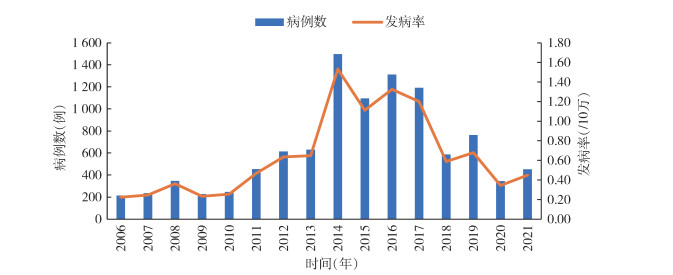
|
| 图 1 2006-2021年山东省恙虫病病例数和发病率时间分布 Figure 1 Temporal distribution of the number and incidence of scrub typhus cases in Shandong Province, China, 2006-2021 |
| |
病例中男性病例4 500例,占比为44.09%,年均报告发病率为0.60/10万,女性病例5 707例,占比为55.91%,年均报告发病率为0.77/10万,男女性别比为1∶1.27。病例主要分布在40~ < 80岁年龄组,占总报告病例数的83.83%。职业分布以农民为主,占总发病数的88.28%,其次是学生和散居儿童、工人、离退休人员、家务及待业者和其他,分别占总发病数的2.86%、2.02%、1.92%、1.88%和3.04%。
2.1.3 地区分布全省除德州市以外的15个地级市均有病例报告,累计波及全省95个县(区)。报告病例数排前5位的分别为临沂(2 665例,26.11%)、日照(1 283例,12.57%)、泰安(1 178例,11.54%)、潍坊(1 166例,11.42%)和青岛市(1 086例,10.64%)。报告病例数排前5位的县(区)是泰安市新泰市(721例,7.06%)、日照市东港区(547例,5.36%)、临沂市郯城县(516例,5.06%)、临沂市兰陵县(515例,5.05%)和淄博市沂源县(459例,4.50%)。发病率最高的区(县)是2016年的新泰市(11.70/10万)。疫情波及县(区)数由2006年的29个增加到2019年的72个,高发地区有向东移动并逐渐扩大的趋势。见图 2。

|
| 图 2 2006-2021年山东省恙虫病发病率地区分布 Figure 2 Regional distribution of incidence of scrub typhus in Shandong Province, China, 2006-2021 |
| |
2006-2021年山东省恙虫病年发病时间分布较为一致,具有明显的季节性,呈单峰分布。病例集中在10-11月,每年9月病例数开始增加,10月达到高峰,11月病例数开始下降(图 3)。9-11月共报告病例9 702例,占报告病例总数的95.05%。
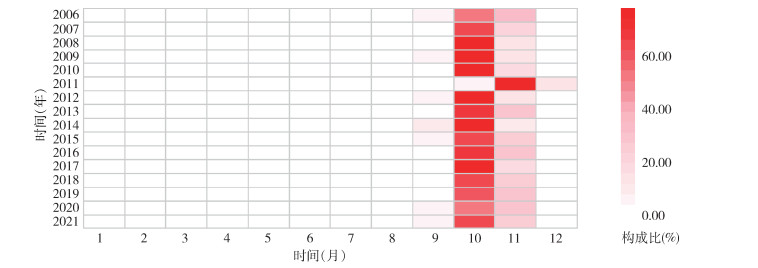
|
| 图 3 2006-2021年山东省恙虫病各月病例数构成比热图 Figure 3 Heat map of monthly composition of number of scrub typhus cases in Shandong Province, China, 2006-2021 |
| |
对2006-2021年山东省恙虫病发病率进行逐年全局自相关分析,结果显示,全局Moran’s I指数为0.203~0.676,且均P < 0.001(表 1),整体趋势为先上升后下降,其中2018年空间自相关最强。
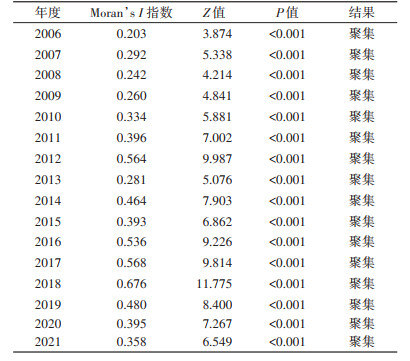
|
对2006-2021年山东省恙虫病进行局部空间自相关分析来进一步确定其高-高聚集区、低-低聚集区、高-低聚集区和低-高聚集区。高-高聚集区最初主要集中在中部的莱芜区、钢城区、新泰市等以及东南部的沂水县、莒县和五莲县等地,随后向周边扩展,形成了一个更大的、连续的恙虫病发病区域。2014年以后,在南部的峄城区、台儿庄区、兰陵县、罗庄区等县(区)也形成了一个稳定的高-高聚集区。此外,还观察到2008-2012年威海市文登区一直为高-低聚集区。见图 4。
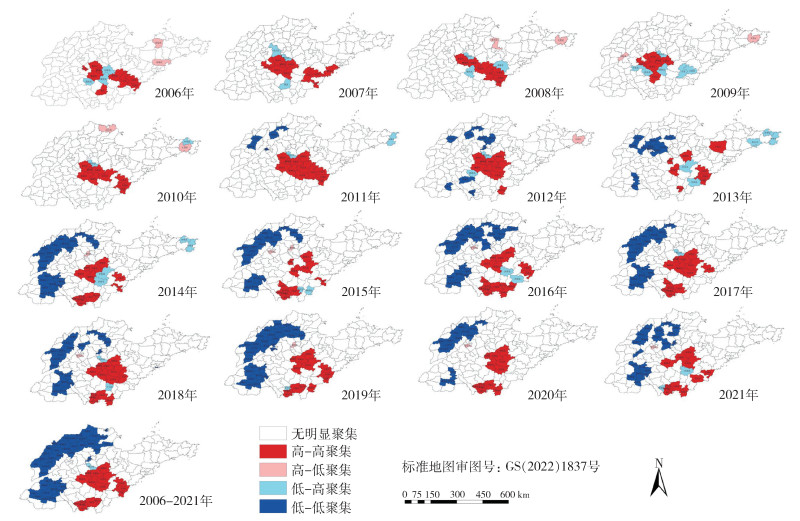
|
| 图 4 2006-2021年山东省恙虫病发病率局部空间自相关聚类图 Figure 4 Local spatial autocorrelation cluster maps for incidence of scrub typhus in Shandong Province, 2006-2021 |
| |
2006-2021年山东省恙虫病病例呈聚集性分布,各年份有统计学意义的聚集区见表 2。一类聚集区在2006-2012年主要集中在中部和南部山区。2012年以后,聚集区范围不断扩大,聚集在中南部山区以及东部丘陵地区。

|
根据时空扫描结果,发现一个以日照市东港区为中心、辐射半径为199.11 km的聚集区(图 5),该聚集区覆盖了2014年10月1日-2017年11月30日期间的49个县(区),相对危险度(RR)值=8.24,LLR=4 107.176(P < 0.01)。
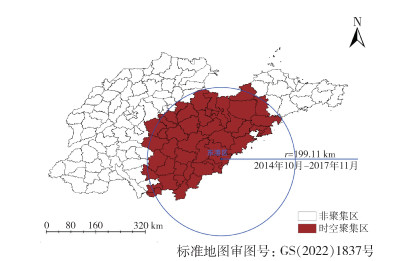
|
| 图 5 2006-2021年山东省恙虫病时空扫描聚集图 Figure 5 Spatiotemporal clusters of scrub typhus in Shandong Province, 2006-2021 |
| |
恙虫病作为自然疫源性疾病,其流行往往与气候、地理等环境要素有关[6-8],从而具有不同的地域特征[9]。本研究对2006-2021年山东省恙虫病病例资料进行全局自相关分析,发现山东省恙虫病存在空间自相关性,通过局部自相关分析和聚集性分析,确定了山东省恙虫病高发病率聚集区以及风险大小。
山东省2006-2021年的病例中临床诊断病例和实验室确诊病例为10 207例,疑似病例为60例(占比0.58%),由于疑似病例占比少,同时为保证分析结果的可靠性和准确性,本研究剔除了诊断不明的疑似病例。2013年以前山东省恙虫病年发病率相对稳定,呈缓慢上升趋势,2013-2014年恙虫病发病率急剧上升,可能是因为当时山东省积极推进禁止秸秆焚烧和秸秆综合利用工作,但当时技术推广不到位且秸秆利用成本高,农忙时劳动力相对缺乏,群众积极性较低[10],秋收后大量秸秆未能及时处理而在田间堆积,为恙螨和鼠的活动和繁殖提供了良好的场所,从而增加了农民被恙螨叮咬的风险。其次,山东省疾病预防控制中心于2013年4月-2015年12月,在临沂、淄博、泰安、青岛和莱芜市(现为济南市莱芜区)的部分地区开展了恙虫病主动监测[11],这可能导致了2013年后恙虫病报告病例的急剧增加。最后,检测设施的普及也可能促进了恙虫病的诊断和报告。2014年达到峰值,之后呈现下降趋势,这可能与近年来山东省秸秆利用率不断提高减少了鼠、螨的孳生场所有一定关系。
时间分布上,山东省恙虫病病例主要集中在10-11月,与北京市、安徽省和江苏省等[12-14]北方地区有相同的发病季节特征,属于秋冬型恙虫病。可能与以下因素有关,首先,10-11月山东省恙虫病的主要储存宿主黑线姬鼠(Apodemus agrarius)和主要传播媒介小盾纤恙螨(Leptotrombidium deliense)的密度增加[15-16];同时,10-11月为农忙季节,农民的户外活动增多,增加了农民与秸秆和恙螨宿主的接触机会。此外,有研究表明,气象因素如温度、日照时数和降水可以影响恙虫病的发病[17-19],山东省10-11月的气候条件可能最适宜恙虫病的发生。本研究发现恙虫病病例主要分布在40~ < 80岁年龄组,职业上以农民为主,且女性发病率高于男性,这可能是因为近年来,农村青壮年大量进城务工,老年人和女性留守在家进行农业和家务活动,由此增加了与恙螨的接触机会[20]。
空间分布上,空间自相关和时空扫描均发现山东省恙虫病呈聚集性分布。病例多集中分布在内陆山区(临沂、泰安市)以及沿海丘陵地区(日照、青岛和潍坊市),在西北和西南部的平原地区则分布较少,这可能与恙螨的地理分布和种群密度有关[21]。恙螨可能在低山和丘陵地区更为丰富,山区和丘陵地区植被覆盖率高、气温适宜、降水充足,湿润温暖的环境有利于恙螨的生存和繁殖。从空间扫描聚集图可以看出聚集区面积不断扩大,不断形成新的疫区,这种现象可能与气象因素如降水量等有关。此外,农、林业基本建设和发展也可能对恙螨和鼠类的栖息环境产生影响[22-23]。为了减少恙虫病疫情的发生与传播,应采取有效措施,例如加快秸秆的利用、加强对重点地区的疾病和宿主媒介的监测、重视对高危人群的健康宣教以及提高医务人员特别是基层医务人员的恙虫病早期诊断能力。
本研究采用了空间自相关和时空扫描统计的方法,对山东省2006-2021年的恙虫病发病情况进行了分析,初步确定了山东省恙虫病的流行特征和时空聚集情况,对恙虫病的监测以及防控策略的制定具有一定的意义。但本研究仍有一定的局限性,首先本研究数据来源于中国疾病预防控制信息系统的“传染病报告信息管理系统”,病例以临床诊断为主,可能存在误报、漏报的情况。其次,本研究未能将影响恙虫病时空分布的其他自然和社会因素纳入研究,未来可纳入多种因素进行深入分析。
利益冲突 无
| [1] |
Guan XG, Wei YH, Jiang BG, et al. Clinical characteristics and risk factors for severe scrub typhus in pediatric and elderly patients[J]. PLoS Negl Trop Dis, 2022, 16(4): e0010357. DOI:10.1371/journal.pntd.0010357 |
| [2] |
李文, 李贵昌, 刘小波, 等. 恙虫病流行特征及影响因素研究进展[J]. 中国媒介生物学及控制杂志, 2020, 31(6): 738-743. Li W, Li GC, Liu XB, et al. Research progress in epidemiological characteristics and influencing factors of scrub typhus[J]. Chin J Vector Biol Control, 2020, 31(6): 738-743. DOI:10.11853/j.issn.1003.8280.2020.06.025 |
| [3] |
Kwak J, Kim S, Kim G, et al. Scrub typhus incidence modeling with meteorological factors in South Korea[J]. Int J Environ Res Public Health, 2015, 12(7): 7254-7273. DOI:10.3390/ijerph120707254 |
| [4] |
丁磊, 王显军, 李忠, 等. 山东地区2010年秋冬型恙虫病流行特征及影响因素[J]. 中国公共卫生, 2013, 29(4): 543-545. Ding L, Wang XJ, Li Z, et al. Epidemic characteristics and related factors of autumn-winter type scrub typhus in Shandong area, 2010[J]. Chin J Public Health, 2013, 29(4): 543-545. DOI:10.11847/zgggws2013-29-04-26 |
| [5] |
杨慧, 毕振旺, 寇增强, 等. 山东省2006-2014年秋冬型恙虫病空间流行病学分析[J]. 中华流行病学杂志, 2016, 37(5): 682-685. Yang H, Bi ZW, Kou ZQ, et al. Spatial analysis of autumn-winter type scrub typhus in Shandong Province, 2006-2014[J]. Chin J Epidemiol, 2016, 37(5): 682-685. DOI:10.3760/cma.j.issn.0254-6450.2016.05.019 |
| [6] |
Luo YZ, Zhang LY, Lv H, et al. How meteorological factors impacting on scrub typhus incidences in the main epidemic areas of 10 provinces, China, 2006-2018[J]. Front Public Health, 2022, 10: 992555. DOI:10.3389/fpubh.2022.992555 |
| [7] |
He JY, Wang Y, Liu P, et al. Co-effects of global climatic dynamics and local climatic factors on scrub typhus in Chinese mainland based on a nine-year time-frequency analysis[J]. One Health, 2022, 15: 100446. DOI:10.1016/j.onehlt.2022.100446 |
| [8] |
Roberts T, Parker DM, Bulterys PL, et al. A spatio-temporal analysis of scrub typhus and murine typhus in Laos; implications from changing landscapes and climate[J]. PLoS Negl Trop Dis, 2021, 15(8): e0009685. DOI:10.1371/journal.pntd.0009685 |
| [9] |
张育富, 刘大鹏, 褚宏亮. 江苏省2008-2017年恙虫病流行特征和时空聚集性分析[J]. 中国媒介生物学及控制杂志, 2019, 30(3): 237-243. Zhang YF, Liu DP, Chu HL, et al. An analysis of epidemiological characteristics and spatiotemporal clustering of scrub typhus in Jiangsu Province, China, during 2008-2017[J]. Chin J Vector Biol Control, 2019, 30(3): 237-243. DOI:10.11853/j.issn.1003.8280.2019.03.002 |
| [10] |
郑军, 史建民. 我国农作物秸秆资源化利用的特征和困境及出路: 以山东为例[J]. 农业现代化研究, 2012, 33(3): 354-358. Zheng J, Shi JM. Utilization of crop straw: Current situation, dilemma of micro-economics and ways out, taking Shandong Province as example[J]. Res Agric Modern, 2012, 33(3): 354-358. DOI:10.3969/j.issn.1000-0275.2012.03.022 |
| [11] |
Chen R, Kou ZQ, Xu LC, et al. Analysis of epidemiological characteristics of four natural-focal diseases in Shandong Province, China in 2009-2017: A descriptive analysis[J]. PLoS One, 2019, 14(8): e0221677. DOI:10.1371/journal.pone.0221677 |
| [12] |
王玉姣, 闫冬明, 李贵昌, 等. 北京市平谷区2008-2018年恙虫病流行特征分析[J]. 中国媒介生物学及控制杂志, 2019, 30(3): 244-247. Wang YJ, Yan DM, Li GC, et al. Epidemiological characteristics of scrub typhus in Pinggu District of Beijing, China, in 2008-2018[J]. Chin J Vector Biol Control, 2019, 30(3): 244-247. DOI:10.11853/j.issn.1003.8280.2019.03.003 |
| [13] |
Wei XY, He JY, Yin WW, et al. Spatiotemporal dynamics and environmental determinants of scrub typhus in Anhui Province, China, 2010-2020[J]. Sci Rep, 2023, 13(1): 2131. DOI:10.1038/s41598-023-29373-7 |
| [14] |
陈安喜, 孔卫荣, 田野, 等. 江苏省常州市2012-2021年恙虫病流行特征分析[J]. 中国媒介生物学及控制杂志, 2023, 34(3): 372-377. Chen AX, Kong WR, Tian Y, et al. Epidemiological characteristics of scrub typhus in Changzhou, Jiangsu Province, China, 2012-2021[J]. Chin J Vector Biol Control, 2023, 34(3): 372-377. DOI:10.11853/j.issn.1003.8280.2023.03.015 |
| [15] |
Huang XD, Cheng P, Zhao YQ, et al. Chigger mite (Acari: Trombiculidae) survey of rodents in Shandong Province, Northern China[J]. Korean J Parasitol, 2017, 55(5): 555-559. DOI:10.3347/kjp.2017.55.5.555 |
| [16] |
Li F, Zhang ZT, Fang LZ, et al. Indoor and outdoor rodent hosts of Orientia tsutsugamushi, Shandong Province, China[J]. Emerg Infect Dis, 2021, 27(10): 2731-2734. DOI:10.3201/eid2710.210393 |
| [17] |
孙烨, 史超, 李新楼, 等. 云南省2006-2013年恙虫病流行特征及影响因素研究[J]. 中华流行病学杂志, 2018, 39(1): 54-57. Sun Y, Shi C, Li XL, et al. Epidemiology of scrub typhus and influencing factors in Yunnan Province, 2006-2013[J]. Chin J Epidemiol, 2018, 39(1): 54-57. DOI:10.3760/cma.j.issn.0254-6450.2018.01.011 |
| [18] |
郭志南, 林勇, 陈国伟. 厦门市2013-2015年恙虫病流行特征和感染危险因素分析[J]. 中华卫生杀虫药械, 2017, 23(4): 337-339. Guo ZN, Lin Y, Chen GW. Epidemic characteristics and risk factors associated with scrub typhus in Xiamen from 2013 to 2015[J]. Chin J Hyg Insect Equip, 2017, 23(4): 337-339. DOI:10.19821/j.1671-2781.2017.04.013 |
| [19] |
Liao HX, Hu JL, Shan XZ, et al. The temporal lagged relationship between meteorological factors and scrub typhus with the distributed lag non-linear model in rural southwest China[J]. Front Public Health, 2022, 10: 926641. DOI:10.3389/fpubh.2022.926641 |
| [20] |
Wei YH, Huang Y, Luo L, et al. Rapid increase of scrub typhus: An epidemiology and spatial-temporal cluster analysis in Guangzhou City, Southern China, 2006-2012[J]. PLoS One, 2014, 9(7): e101976. DOI:10.1371/journal.pone.0101976 |
| [21] |
Lee IY, Kim HC, Lee YS, et al. Geographical distribution and relative abundance of vectors of scrub typhus in the Republic of Korea[J]. Korean J Parasitol, 2009, 47(4): 381-386. DOI:10.3347/kjp.2009.47.4.381 |
| [22] |
Min KD, Lee JY, So Y, et al. Deforestation increases the risk of scrub typhus in Korea[J]. Int J Environ Res Public Health, 2019, 16(9): 1518. DOI:10.3390/ijerph16091518 |
| [23] |
Yang LP, Liu J, Wang XJ, et al. Effects of meteorological factors on scrub typhus in a temperate region of China[J]. Epidemiol Infect, 2014, 142(10): 2217-2226. DOI:10.1017/s0950268813003208 |
 2024, Vol. 35
2024, Vol. 35


